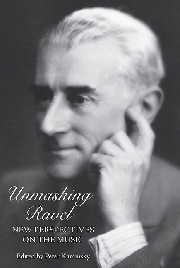Book contents
- Frontmatter
- Dedication
- Contents
- Acknowledgments
- Introduction
- Part One Orientations and Influences
- Part Two Analytical Case Studies
- Part Three Interdisciplinary Perspectives
- 9 Deception, Reality, and Changes of Perspective in Two Songs from Histoires naturelles
- 10 Not Just a Pretty Surface: Ornament and Metric Complexity in Ravel's Piano Music
- 11 The Child on the Couch; or, Toward a (Psycho) Analysis of Ravel's L'enfant et les sortilèges
- List of Contributors
- Index
11 - The Child on the Couch; or, Toward a (Psycho) Analysis of Ravel's L'enfant et les sortilèges
from Part Three - Interdisciplinary Perspectives
Published online by Cambridge University Press: 05 September 2013
- Frontmatter
- Dedication
- Contents
- Acknowledgments
- Introduction
- Part One Orientations and Influences
- Part Two Analytical Case Studies
- Part Three Interdisciplinary Perspectives
- 9 Deception, Reality, and Changes of Perspective in Two Songs from Histoires naturelles
- 10 Not Just a Pretty Surface: Ornament and Metric Complexity in Ravel's Piano Music
- 11 The Child on the Couch; or, Toward a (Psycho) Analysis of Ravel's L'enfant et les sortilèges
- List of Contributors
- Index
Summary
During World War I, Colette wrote a ballet scenario on a commission from Jacques Rouché, director of the Paris Opéra, who suggested Ravel as an appropriate composer. A copy of the scenario was sent to the front, but Ravel neither received nor saw it until he returned from his service as an ambulance driver in 1918. Colette's story, with its vivid depiction of the joys and especially the terrors of childhood, brimming with potent psychological overtones, dovetailed beautifully with Ravel's lifelong attraction to themes of childhood, toys, machines, automata, and magic. With the rise of Les Six, a new generation of French composers seeking to move beyond the heritage of Debussy and Ravel, L'enfant et les sortilèges presented Ravel with an opportunity to remain artistically relevant by revitalizing his musical language; hence the assimilation of American jazz and blues, polytonality, and an increased emphasis on linear counterpoint in L'enfant and his works of the 1920s. The resulting ballet-opera, which premiered in Monte Carlo in March of 1925, may be unique in the opera literature in telling its story from the point of view of a six-year-old child.
My study of L'enfant et les sortilèges will proceed in three parts. Part 1 summarizes Colette's story and goes on to trace the origin of its psychoanalytic interpretation and briefly assess the influence of this interpretation on subsequent commentary on the opera. I then propose a mapping between Ravel's music and the psychological overtones of the story, as viewed through a selective psychoanalytic lens.
- Type
- Chapter
- Information
- Unmasking RavelNew Perspectives on the Music, pp. 306 - 330Publisher: Boydell & BrewerPrint publication year: 2011



